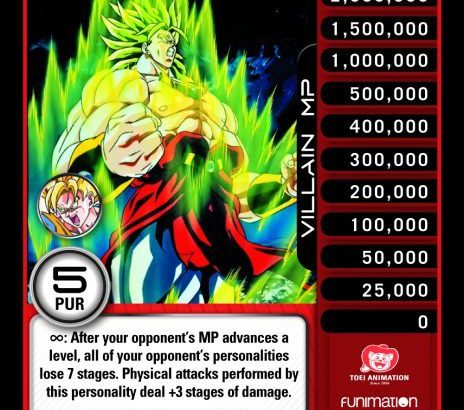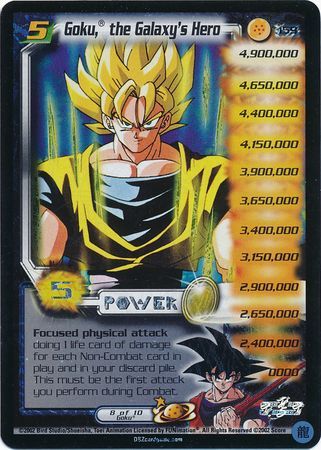In response to the Dragon Ball Z revival with the film “Battle of Gods”, the Dragon Ball Z CCG was brought back as the Dragon Ball Z TCG by Panini, a company known for sticker albums that had bought Donruss, the parent company of Score, since the end of ‘Re-Z’, the last revival of the DBZ CCG.
Developed by many people behind the Score version, Panini’s DBZ TCG brings on some of the terminology changes from the Dragon Ball GT TCG, standardizes personality stacks to 4 levels, changes Most Powerful Personality Victory to 5 anger on Level 4, makes Allies their own card type and introduces the concept of Critical Damage.
A considerable improvement over the original game, today we will be taking a look at the top 10 Main Personality cards from Panini’s Dragon Ball Z TCG. The game only lasted 7 sets, so we will not be seeing any characters from the Otherworld Tournament arc or beyond. Personality cards were chosen not only for their overall power, but their impact upon the game and the length of their relevancy.
10 – GOKU – SUPER SAIYAN

Goku was not terribly impressive early on in the history of Panini’s Dragon Ball Z TCG. Not for the vast majority who ended up settling on Black Krillin, Namekian Piccolo and some flavor of Captain Ginyu. Goku certainly worked and had potential, but he wasn’t quite there. The thing about Goku was, with how he was designed, he would only get better as the game progressed.
Goku – Super Saiyan is a very simple card, but also incredibly powerful. Search the Life Deck, Discard Pile and Banished Zone for up to 5 Drills and place them into play. It doesn’t matter how your opponent answers your Drills, you just get fully set up in one sweep. If you have Orange Torching Drill out, you’ll mill your opponent 5 cards in one go and there isn’t anything they can do about it. There is also no limitation placed upon the Drills, they can be non-Styled and of any effect type.
While it’s easy to see how Goku – Super Saiyan would continuously gain steam over time, he is Level 4. Orange and Goku himself do have support for leveling such as Goku’s Kaio Ken and Orange Devouring Drill, but this is very, very far into the game and most of Orange’s Drill support won’t trigger Orange Devouring Drill. But, if you can get there, he’s probably one of the most effective Level 4 personality cards in the game.
9 – ANDROID 20 – UNFAZED

Android 20 is the villainous counterpart to the Premier Goku stack, being focused around non-Styled Drills. The only stand out personality from Evolution, Android 20 is also far more powerful than Goku when taken as a whole, unlike Goku, his Level 2 and 3 are actually really good. Good enough to make the finals of the 2015 World Tournament an Orange Adaptive Android 20 mirror match.
Android 20 – Unfazed has two powers. The first allows him to Rejuvenate 3 at the end of combat if you control a non-Styled Drill. Androids have a non-Styled Drill, as does Android 20, and the game had developed a decent array of non-Styled Drills by that time. He also searches for Non-Styled Drills and is being run with Orange Adaptive, so he’s Rejuvenating 3 at the end of each combat. This is enough to shrug off a decent amount of attacks and refuel his own Scouting Drill.
Secondly, when entering combat, you can search your Life Deck or Discard Pile for a non-Styled Drill and play it. The phrasing here is very important as this triggers Orange Devouring Drill, it needs Drills to be played, not placed into play, but this causes Android 20 to jump up to Android 20 – Surprised, the “kill switch” of the deck.
Android 20 continues the tradition of this game where unlikely characters become incredibly strong personality stacks. There is a very solid argument that Android 20 – Surprised should be on this list over Unfazed, but if you are stuck on Unfazed for whatever reason, he puts in a ton of work to get you the win.
8 – YAMCHA – SURPRISED

Yamcha is not the first character you’d think of for an aggressive deck, but his stack is perfect for Energy Beats, in particular Orange Energy Beats. Yamcha -Surprised isn’t terribly hard to get to with Orange via Orange Devouring Drill and Orange Captivity Drill, but offers so much for the build.
Yamcha natively reduces all your stage costs for Energy Attacks by 1 and makes their damage unpreventable, meaning what they say, they do and will very likely hit the critical damage threshold thanks to Orange Aura Drill and Orange Adaptive Mastery increasing their damage output. Said damage outout even plays into Orange Adaptive Mastery, securing you Critical Damage.
He also has a Power to draw a card and lower your opponent’s Anger 2. This can be comboed with cards such as Orange Distracting Beam to draw exactly what you want. Then finally, when you reach Yamcha – Surprised, you draw a card. Actions mean everything in the Score Dragon Ball Z liniage, so a +2 on top of the +1 Yamcha – On the Move can produce and the +2 Possession Drill can get you, that’s a lot of potential additional actions.
Panini’s Dragon Ball Z design team heavily favored defensive ‘stasis’ decks through most of the game and Yamcha was intended as one looking at his Named cards, along with the secondary effects of Yamcha – Sleeping, but he ends up more suited to Orange’s flavor of energy beats and the game was all the better for it. Panini Dragon Ball Z desperately needed a more aggro flavored experience.
7 – TRUNKS – DASHING
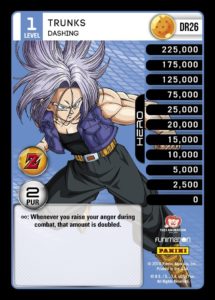
Trunks – Dashing is by far one of the most simple and effective cards on this list. Whenever you raise your Anger during combat, double that amount. 1 becomes 2, 2 becomes 4. That second one, that’s where you focus.
Trunks is most commonly used in the Saiyan Style with Saiyan Rampaging Mastery, a card that reduces the amount of anger you need to advance a level by 1. Unless you’re against Blue Protective Mastery, which isn’t likely, Trunks only needs one card that raises his anger by 2 to level him from 1 to 2.
He can typically do this very early in the game, including his first action. Even if you get something that will just raise your Anger 1, so long as it is Styled, with an additional effect of Saiyan Rampaging Mastery, your Styled attacks gain “HIT: You may raise your Anger 1.”, you can still reach Level 2 in one action.
The rest of Trunks’ personality stack from Awakening plays into the anger theme and Saiyan Rampaging Mastery, but also Sword cards, of which Saiyan has some of the more notable ones, and Trunks’ named cards, Trunks becomes quite the formidable MPPV Survival Hybrid deck.
6 – KRILLIN – READY – PROMO VERSION

Krillin was from a set of five promo cards released prior to Panini’s DBZ officially launching and one of only two cards of note from the set. All of the cards have irregularities in their text box, clearly being from an unfinished state, but Krillin is different from the other three that appeared in Premier in that his functionality changed between this issue and the proper Premier release.
Krillin is packing an energy attack that costs 2 power stages and deals 4 life cards of damage with the secondary effect that the next time a card is discarded from a hand that combat, use a Critical Damage effect. This is either lowering your opponent’s Anger 1, capturing a Dragon Ball or discarding an Ally.
Being paired with Black Devious Mastery, Krillin’s attacks are stronger, including his unblockable and unpreventable Destructo Disk, but he also gains the ability to force a discard from his own hand, along with additional effects provided by the Mastery. This allowed Krillin a formidable control package built into two cards that start and stay in play. The Premier version of this card would also raise his Hyper 2 in an effort to push him off this level, though this card was never errata-ed to reflect the later release.
5 – CAPTAIN GINYU – LEADER

Being a recreation of Score’s Dragon Ball Z CCG from 2000, Panini’s Dragon Ball Z TCG includes a lot of direct connections to the original game, from direct reprints to cards made in the spirit of an older card. Captain Ginyu is based on Bojack from the original Score game, being an ally focused deck, with his Lv3 being a near direct lift of Bojack’s Lv3 and both Captain Ginyu Lv1 and Lv2 being made in the spirit of Bojack.
Captain Ginyu – Leader is packing an energy attack costing 3 stages and dealing 4 life cards of damage that searches for an ally and places it into play, then if it hits you can target one of your allies, not necessarily the same one, and it can make actions that combat. While 3 stages may seem like a hefty cost despite being worth the effect, it’s actually a benefit due to how allies work. As soon as you are 1 power stage above 0 or are at 0, you can use your allies in combat regardless.
Typically run in a control focused blue, black or orange deck and always with his Ginyu Force, Captain Ginyu searching out his Allies afforded him additional damage modifiers and actions each combat, which in turn caused Ginyu to become one of the most prominent main personalities for nearly half of Pan Z’s life.
4 – PICCOLO – COMBAT STANCE
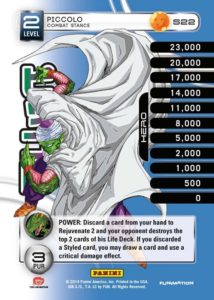
Piccolo – Combat Stance is something of a strange card in retrospect. It both fits the rest of his personality stack from Premier, but it doesn’t. While the rest of Piccolo’s stack is all about energy attacks, critical damage, rejuvenation and dragon balls, Piccolo – Combat Stance is a far more control focused card, yet still manages to fit the themes.
Unlike the rest of the most prominent personalities of early Pan Z, Piccolo does not pack an attack, instead he packs an activated power. For the cost of discard 1, you; rejuvenate 2, mill your opponent 2, then if you discarded a Styled card for the cost, draw a card and use a critical damage effect.
While this seems like a lot, considering it’s not a direct attack, it has to do so much to be worth using, however that value proped it up considerably. The discard 1 then if styled draw 1 transforms the effect into a way to drop cards you don’t need. A hand filter. Secondly, the critical damage effect on demand, great for getting rid of Allies or capturing Dragon Balls and considering that Piccolo is typically run in Namekian, he will have a full suite of Dragon Balls. While Pan Z was designed to encourage leveling, Piccolo – Stoic is antithetical to that design. You want to sit on him rather than level up further.
3 – ANDROID 13 – DARK VILLAIN

Vengeance really was when Physical Beats finally came to full form with two fairly overpowering personality stacks, starting with Android 13.
Android 13 – Dark Villain has two powers, the first being an instant power; when you enter combat, your opponent loses 4 stages and skips their first action that combat. 4 stages is just under half and turns into discard if they hit 0 before the effect is finished or are at 0 stages when it is used. The skip allows Android 13 to get in a shot before their opponent has a chance to do anything if they enter on you. If you enter with Android 13, you get two actions in a row due to your opponent skipping their first.
His second power is a physical attack for 7 stages with the hit effect to shut off their continuous powers for the turn. All of them; Main Personalities, Masteries, Drills and Allies. This is not used with the intent of having it hit, but baiting out a stop. It’s far too damaging to let hit, but only strong if used very early each combat.
Android 13 was used in every style he could use bar Orange, but mostly found a home in Black or Red. Whether he was the best physical choice from Vengeance is hard to say, but he was a very strong meta choice.
2 – BROLY – LEGENDARY
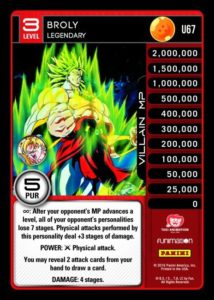
Broly is rather interesting from a design standpoint in that he’s both clearly pushed as a personality stack, as he rightfully should be for a character of his popularity, but is inspired by what players did with him in Score Dragon Ball Z, incorporating themes of Trunks Saga Saiyan Style Mastery.
Broly starts with a continuous power that causes all opponent’s personalities to lose 7 stages when they advance a level. MPs get set at 3 above 0 while Allies just lose stages. If a personality has 0 stages and would lose stages, it’s taken as life card damage instead. He also buffs your physical attacks by +3 Stages, a very high value modifier to physical beatdown.
Broly’s second power is a Physical Attack for 4 Stages, or 7 with his first power, that allows you to reveal two Attack cards to draw a card. Not just a +1 for 7 stage damage, but a +1 that becomes a further +1 for revealing information to your opponent. Yes this helps your opponent choose what to block, but you’re playing beatdown, chances are they’re seeing them all anyway.
Panini’s version of DBZ had issues since day 1 with aggro not being viable. Like how Yamcha answered this for Energy focused decks in Perfection, Broly answers this for Physical focused decks in Vengence. While not locked to Saiyan like the original, he is still a premier choice for Saiyan Physical Beats. He also has quite a nice home in Red.
1 – CELL – UNSTOPPABLE
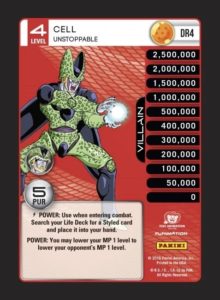
It’s a good thing when popular personalities are strong, viable and formidable for both competitive and casual play. It’s not a good thing when they actively nullify an aspect of the game that brings people joy. Cell – Unstoppable was firmly in the latter camp.
Cell – Unstoppable has two powers; the first is used when entering combat. It allows him to search for any Styled card and place it into his hand. Incredibly strong +1, but nothing too outrageous as the most format defining cards are typically non-Styled.
His second power allows him to lower his level to lower his opponent’s level. Combine this with his Level 3 which keeps getting you back to Level 4 as the floating effect of a Physical Attack dealing 7 Life Cards that is unpreventable and banishing cards from your opponent’s discard pile. You can effectively reduce your opponent to Level 1 and keep them there indefinitely as you repeatedly jump to Level 4, then reduce yourself to Level 3.
Cell – Unstoppable was so overpushed that he received an errata to restrict his lowering power to just once per game. No other main personality card in Panini’s run got this type of neutering and that earns him the top spot.
The Final Word:
All in all, Panini created powerful personality cards for the most recognizable characters from Dragon Ball Z. The unlikely Yamcha made the list despite being one of the weakest members of the Z-Fighters. The value of these personalities go beyond their power levels. These main personalities have powerful effects and powers, and these abilities put them above the competition.
This is our list of the top ten personalities from Dragon Ball Z: Trading Card Game by Panini. Your top cards may not have made our list. Place your list of your top ten main personalities from Dragon Ball Z: Trading Card Game by Panini in the comments.

